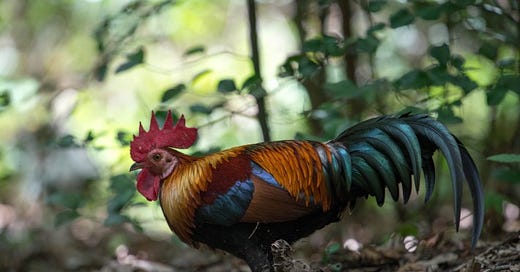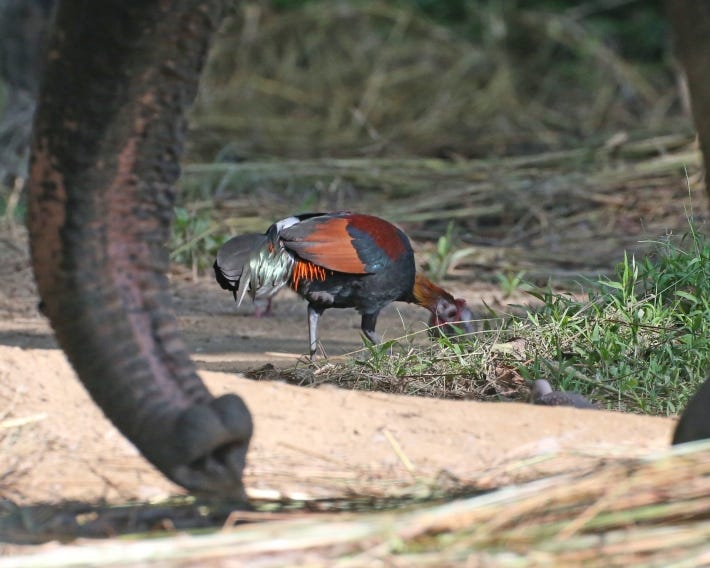
You may think you recognize this week's Bird of the Week. Here, take a look.
It's a chicken, right? WRONG. (But also kind of right.) This bird right here is the red junglefowl. It is the wild bird that, many thousands of years ago, was domesticated by humans into the chicken we all know. As Audobon's Andrew Lawler wrote in 2014: "Twenty billion. That’s the minimum number of chickens pecking at the earth’s surface on any given day. And every one of them is descended directly from the Red Junglefowl." Wowza.
And it is still out there and the world, roaming the wilds of Southeast Asia. Isn't nature a wonderful thing? Because I am a dummy, I had literally never contemplated where the chicken came from. It came from this bird!
The first thing you notice about the red junglefowl is that it looks incredible. This is what happens when you swerved thousands of years of aggressive human-driven breeding. This is what nature intended the chicken to look like: flashy as hell. Another pic, featuring an elephant!
How did we get from the red junglefowl to the chicken? That is way too complicated for Bird of the Week but it happened an extremely long time ago. Some articles say it was between 4,000 and 8,000 years ago. Some say it was between 7,000 and 10,000 years ago! But the bottom line is that it happened in the very distant past, and it happened in Asia. (And, though it appears that the red junglefowl is the patient zero, other varieties of junglefowl made their way into the mix too.) As people moved and expanded around the world, so did the chicken, and here we are today.
There are some key differences between the junglefowl and its descendant. The junglefowl is smaller than most domesticated chickens. One study says its brain is bigger. And, according to ChickenMag, a website about chickens, its egg-laying is more inconsistent than the tame breeds, which makes sense, because it was not bred to lay eggs for humans all the time. (ChickenMag is as enthusiastic about the red junglefowl as me, proclaiming, "Remember; no matter what breed of chicken you actually have, there will always be a small amount of Red Junglefowl in it. This incredibly exciting!" Show me the lie!)
The junglefowl also crows in a slightly different way from your common rooster; the Cornell Lab of Ornithology says that "the crowing is hoarse and choked off towards the end, unlike the loud, vibrant calls of the domestic rooster." Here is video evidence of that, where you also see the hens:
And here's a video of a junglefowl in flight!
Love it. But all is not well in junglefowl land, because of—you guessed it!!!—humans. From Audobon (emphasis mine):
Despite our tight bond with the chicken, the wild Red Junglefowl remains surprisingly mysterious. It is notoriously shy and difficult to observe, hunt, or capture in its native habitat; just handling one can prompt its heart to fail. Unfortunately, as human populations have exploded in South Asia, so have barnyard chickens, leading to hybridization. The result is that the common chicken’s relentless spread is quietly driving its ancestor to genetic extinction.
Our best glimpse into the nature of the unalloyed wild chicken therefore comes from historical accounts. “An untamable leopard; low-hung tail, slightly bent legs; head low, always intent, listening, watching; almost never motionless,” is how a 34-year-old biologist named William Beebe described a Red Junglefowl that he watched one chilly dawn in a damp upland forest in Burma. The year was 1911, and Beebe was on the path to becoming one of the world’s most renowned wildlife biologists. Peering through his binoculars, the explorer watched transfixed as the rising sun pierced the woods, striking the bird. “Just for a moment he was agleam, the sun reflecting metallic red, green, and purple from his plumage.”
Beautiful, a world to which we can never return. Stay strong, red junglefowl!!!! Don't let your heart fail! We need you.
A reminder: you can check out our complete Bird of the Week list here, and get in touch with your bird suggestions at hello@discourseblog.com.














